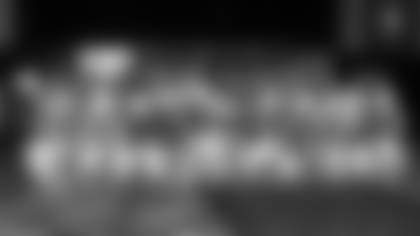The NFL Draft is moving on to the next step in the process for this year's rookie class with the NFL Scouting Combine in Indianapolis next week.
Teams will now work on completing their scouting reports with medical evaluations, getting to know prospects in interviews, and accumulating data to complete athletic profiles. For quarterbacks, this is often where the top prospects separate themselves.
With quarterback being a leadership position, their mental makeup and football intelligence are a huge part of the evaluation. Whether it's fair or not, personality matters, particularly maturity and leadership to step into such a major role, especially when drafting a quarterback in the first round. Plus, coaches and front office personnel will try to go under the hood to test their football IQ, putting quarterbacks on the whiteboard to see how they process the game from a mental standpoint.
With the Patriots in the quarterback market, let's start with a baseline based on the film on the six prospects that graded out with starter potential. Then, we can adjust to what we're hearing from the combine about these incoming rookies.
Here are my pre-combine quarterback tiers and rankings based on their college tape:

Tier One - The Consensus No. 1 Overall Pick
1. Caleb Williams, USC
Pro Comparison: Ceiling - Discount Mahomes, Floor - Russell Wilson
Scheme Fit: West Coast-College (Andy Reid Tree)
The draft discourse surrounding Caleb Williams often has nothing to do with football, but we will discuss him as a prospect rather than overanalyze his personality. If you're out on Williams because he got emotional following losses and wants to build his brand off the field, we won't try to change your mind – it's not worth convincing you to like him.
The bottom line is Williams is the most talented prospect in the entire class, with the tools to develop into an MVP-caliber quarterback at the next level. Williams's arm talent and arm elasticity allow him to access any area of the field in an instant. The former Heisman Trophy winner is an elite playmaker with rare off-script improvisational skills, excellent pocket mobility and elusiveness to extend plays, and rare off-platform velocity from various arm angles, whether his feet are set or not. From a play creation standpoint, Williams gives off Patrick Mahomes vibes in how he forces defenses to cover every blade of grass.
As a prospect on the field, Williams has some developing to do regarding his in-structure timing, decision-making, and ball security. He'll often resort to hero ball rather than play within the scheme's parameters, inviting pressure to the tune of 35 sacks and 18 turnover-worthy players.
Williams will need to play more on time from the pocket and be less reckless as a decision-maker in the pros. From that standpoint, he is a bit raw entering the league. Still, his pure talent and skills as an improviser make him a worthy number-one overall pick.
Carrying Trait: Improvisational Skills, Late-Down Playmaking
This one was easy: Williams's improvisational skills as a passer are the best superpower any quarterback has in this class. Along with the arm talent to push the ball downfield with velocity and touch from different arm angles/platforms, Williams is also extremely elusive while keeping his eyes downfield as he evades pressure to find open receivers.
Here, Williams is immediately under pressure when projected first-round edge rusher Laiatu Latu comes through the line of scrimmage. The initial play design is a middle-read/dagger style concept with running back MarShawn Lloyd releasing harmlessly into the flat. However, as Williams evades Latu's rush to buy himself time, Lloyd sneaks upfield as the flat defender's eyes lock onto Williams. Williams finds clean air and lofts a pass on the money for a big play before the half. To succeed in today's NFL, quarterbacks need to be able to move around and make plays. Williams should be among the league's best QBs late in the down.
Tier Two - Projected Top-10 Picks in the 2024 NFL Draft

2. Drake Maye, UNC
Pro Comparison: Ceiling - Justin Herbert, Floor - Daniel Jones
Scheme Fit: Vertical/Pro-Style (AVP's Dream)
Admittedly, I've flip-flopped throughout this process on these next two quarterbacks, who are both top-10 caliber prospects. Ultimately, it's a flavor thing depending on how you want to run your offense schematically. Honestly, I'm a little surprised at how controversial Maye seems to be as a prospect among Patriots fans. Maye didn't light up college football like Daniels and Williams as former Heisman Trophy winners. But he also didn't have a loaded supporting cast and his skill set fits the modern quarterback to a tee: good size, excellent arm talent, mobility, and playmaking skills with good toughness in the pocket to deliver throws under pressure. Maye is in the Josh Allen or Justin Herbert mold from a stylistic standpoint. Isn't that what every NFL team wants nowadays?
The legitimate knocks on film are Maye's inconsistent footwork and elongated release. He needs to tighten up his release to get the ball out quicker and avoid exposing the ball to pass rushers. As for his footwork, Maye has antsy feet and drifts into pressure at times, which is a real concern. There are too many instances on film where he'll miss open receivers because his feet are unsettled in the pocket. From an overall tools standpoint, it's all there for Maye to develop into an elite starter. However, he'll need to be coached up on the finer mechanical details of the position to reach his ceiling.
Carrying Trait: Attacking the Middle of the Field
There's a playmaking gene to Maye's game that could be seen as a carrying trait with a knack for extending plays either by avoiding or playing through contact. But his ability to both drive the ball and layer throws into the middle of the field stands out the most. Maye is one of the best middle-of-the-field throwers I've studied over the last handful of draft classes, and it's especially intriguing that he can drive the ball between the numbers on a rocket up the seam and throw with touch into a coverage void.
Although it's not as sexy as the off-platform magic, Maye consistently executes NFL-style concepts with good rhythm and ball placement to play in structure. Above, Maye shows off his arm strength to rip a seam route between a triangle of defenders. The ability to drive the ball through the zone structure with pure velocity would be a welcomed departure from the Pats current QBs.
Maye's film is littered with throws on in cuts, crossers, seam shots, and posts where he drops dimes between the numbers. As far as in-structure offense goes, that's the pro game.

3. Jayden Daniels, LSU
Pro Comparison: Ceiling - Lamar Jackson, Floor - Justin Fields
Scheme Fit: Option Spread (Ravens style)
It's incredibly enticing to have a quarterback with Daniels's mobility and big-play creation as an athlete. Opposing defenses will have to game plan for Daniels as a runner every week. Plus, Daniels is starting from a higher point as a thrower than Lamar Jackson was coming out of Louisville, so the Heisman Trophy has a solid baseline from a pro projection standpoint.
Daniels's timing in the passing game has greatly improved, and his throwing motion is consistent and replicable with sound upper-body mechanics. He throws with a snappy release and good rotational core strength to generate velocity from his hips and shoulders, which allows Daniels to generate power in muddy pockets. The LSU product also showed the ability to throw multiple pitches with good touch to layer throws, take a little off passes to lead receivers into YAC, and drop it in the bucket to vertical routes and hole shots. Daniels also has above-average awareness to beat blitzes and make good decisions with the ball.
However, Daniels tends to miss or pass up reads in the middle of the field in favor of running. He is not entirely a one-read quarterback, but there are too many instances where LSU was running concepts that created open receivers that Daniels would ignore. Instead, he'd run. He's so dynamic that he'd get away with that in college, but defenders will close much faster to limit those scramble yards in the NFL. Plus, he can be a bit reckless with how he finishes runs, opting to take on contact rather than protect his wiry frame.
Daniels will need to protect himself better as a runner at the next level, while he'd probably benefit from being in a simplified passing system like Jackson or Eagles QB Jalen Hurts early in his career. Daniels should eventually get there as a field reader, but an option-heavy spread system with a few core concepts on third down will allow him to develop at the right pace. Throwing him into the fire of a complex drop-back passing game that doesn't amplify his mobility could derail Daniels's development.
Carrying Trait: Deep Ball Touch and Timing (Along with Mobility)
Obviously, Daniels's superpower is his electric running ability on designed quarterback runs and as a scrambler. He's a long-strider with excellent burst who can gobble up yards with his legs in a hurry; ask Alabama or Florida, who couldn't contain him even with quarterback spies.
With that said, it's important to articulate that Daniels is a more than capable passer as well. Daniels doesn't have elite arm strength as more a touch thrower than a true driver of the football, but he makes up for any velocity limitations with timing and ball placement.
In this example, Florida State ran an inverted cover two coverage where the outside corner (bottom) rotates into the deep half as the safety to Daniels's left rotates into the middle zone. Daniels reads the coverage rotation and gets this ball out early enough so the boundary corner can't flip his hips back around to make a play on the ball. Plus, he throws the ball to his receiver's back shoulder to keep it out of harm's way. Daniels's ability to throw on-time vertical routes, whether against man or zone coverage, leads to some pretty deep-ball dimes.
Tier Three - Late Day One, Early Day Two Projection (Potential: Above-Average NFL Starter)

4. Michael Penix Jr., Washington
Pro Comparison: Ceiling - Philip Rivers, Floor - Geno Smith
Scheme Fit: Vertical Spread (Arians style)
Penix's performance in the championship game didn't do much to change my opinion of him as a prospect. The truth was always somewhere between his outstanding film in the CFP semifinal (vs. Texas) and the beatdown he took in the loss to Michigan. It also goes without saying that I'm not a doctor evaluating his medicals, which will be a huge factor for NFL teams.
On film, Penix is a late day one, early day two prospect. He can generate plenty of zip on throws from clean pockets with noticeable velocity as the ball explodes out of his hand. He's also arguably the most accurate deep-ball thrower in this class, throwing receivers open consistently on vertical shots and dropping dimes in the bucket on deep crossing routes. Although he's not overly mobile, Penix has flashes of pocket mobility to elude rushers with sudden movements, where he can reset in the pocket and deliver strong throws.
Besides the medical red flags, there are concerns about how Penix handles pressure and the dip in velocity and accuracy when he can't set his feet in the pocket. Those concerns were harder to find outside the title game, but how he looked against Michigan came up in other isolated flashes when he was under pressure. You also wish you saw more layered throws into the middle of the field, where he anticipates and throws accurately between the numbers.
Still, Penix has NFL starter potential and would thrive in a vertical-based passing offense that allows him to attack coverage with pinpoint accuracy down the field. Overall, there's a lot to like about his leadership and ability to battle through adversity through all the injuries. If you want a tough, competitive quarterback who teammates gravitate toward, Penix is your guy.
Carrying Trait: Deep Ball Accuracy
Penix throws more pinpoint deep passes than any quarterback in this class. Last season, the Washington product led the entire FBS with 37 big-time throws on passes over 20 yards.
Penix's specialty is dropping dimes on deep crossing routes where Washington would either have receivers run away from man coverage or flood zones into the sideline. But he'll also hit vertical routes on time with excellent ball placement, as shown above in his film from the CFP semifinal.
Tier Four - Top 50 Projection (Potential: NFL Starter)

5. J.J. McCarthy, Michigan
Pro Comparison: Ceiling - Brock Purdy, Floor - Mitch Trubisky
Scheme Fit: Throwback (Run+Play-Action Heavy)
Draft media and the league are determined to be at odds about McCarthy's potential in the NFL. The league sees a clean prospect without major medical or off-field red flags. McCarthy won in college and has NFL-caliber arm strength and mobility, which is enough for scouts to convince themselves that he's a winning player.
However, the media sees a very raw processor with downright head-scratching decisions on turnover-worthy plays. McCarthy wasn't asked to do much in a run-first, play-action-heavy scheme. He also tends to overthrow passes, which leads to wild misses outside the numbers and a lack of touch on short throws, leaving yards on the field, especially when he should be taking a little off passes to lead receivers into YAC.
We'll see who ends up being correct in the long run, but the fact that we are discussing McCarthy as a top-half of the first-round guy is wild.
Carrying Trait: Pocket Mobility, Throwing on the Move
McCarthy is a good athlete with plus-mobility. He has a decent feel for relocating in the pocket to evade the rush, adds yards on scrambles, and can throw on the move. McCarthy's athleticism allows him to make plays by extending the down, covering up for his current issues playing in structure.
Here, McCarthy does the wise thing to get out of a collapsing pocket without an open receiver in the initial concept. Then, he goes off-script. As his running back breaks upfield, McCarthy finds him along the sideline for an impressive on-the-move throw moving to his non-arm side. The flashes are there for McCarthy to develop into an NFL starter, but he's wildly inconsistent.

6. Bo Nix, Oregon
Pro Comparison: Ceiling - Baker Mayfield, Floor - Drew Lock
Scheme Fit: Traditional West Coast (Short and Intermediate Passing)
Nix is one of those prospects who doesn't necessarily "wow" you with any one trait but is just well-rounded enough that you can convince yourself that he's a starting-caliber quarterback. His best attributes are his clean decision-making, some mobility in and outside the pocket, and he's a thoughtful in-structure thrower with his ball placement.
Along with average arm talent, Nix tends to fade away on throws and loses control of his back foot in his throwing motion, leading to accuracy issues. Nix was a productive high-volume deep thrower at Oregon, but when you study his actual ball placement over 10 yards, his accuracy can be too inconsistent at times.
Nix has enough good film to talk yourself into him being a league-average starter, and he has the experience to play right away. Still, it's hard to envision him having a super high ceiling.
Carrying Trait: Layering Throws, Avoiding Defenders with Ball Placement
The term "throwing the receiver open" applies to Nix, especially with how he attacks the middle of the field and throws receivers open on verticals.
Here, Oregon runs a scissors concept on the three-receiver side, where a post from No. 2 intersects with a corner route from the No. 3 receiver. The passing window is there between the middle hook and the backside short zone defender. However, leading the receiver across the field will throw right into the backside hook. Nix does well to throw this ball at the receiver's back hip to turn him away from the oncoming defender to avoid an interception. That's an NFL-sized passing window and really thoughtful ball placement while accounting for the backside defender.
Tier 5 - Fringe Starter, High-End Backup (Round Projection: 3-4)
7. Spencer Rattler, South Carolina - Rattler has enough arm talent to talk yourself into adding him to your quarterback room as a mid-round pick. He also showed improved timing as a passer at the Senior Bowl. However, he's undersized (6-1, 218), and his accuracy/timing was inconsistent throughout his college film. Again, there are enough flashes, and once upon a time, Rattler was viewed as the next big thing in college. But he's never put the whole package together — a Sam Howell type.
Tier 6 - Developmental Backups (Round Projection: Day Three)
8. Michael Pratt, Tulane - Pratt has the tools to operate as a traditional pocket quarterback with good touch, accuracy, and decent size (6-2, 216). He doesn't have the biggest arm, the game was moving a bit fast for him in Mobile, and he was a tick slow at times through his reads in his Tulane film, and he's rigid in the pocket, which prevents him from generating velocity. Pratt will be a solid backup in the league who could be a low-end starter for a team buying time until they find the guy (pro comparison: Jake Browning).
9. Joe Milton, Tennessee - I'm willing to have some fun with Milton as a developmental prospect because his arm talent, size, and mobility are starting-caliber traits. Bazooka Joe can throw the ball a mile and drive it into tight windows, but his decision-making and erratic accuracy make him a day-three prospect: Big, mobile, strong arm. Where is it going, and is it going to the right team? Who knows (pro comparison: discount Anthony Richardson).
10. Jordan Travis, FSU - Who knows where Travis would be ranked in this quarterback class if it wasn't for a devastating leg injury last November? Travis could've torn up the college football playoff and improved his stock, but his college career ended when he broke his leg on Nov. 18, 2023. Before the injury, Travis was an excellent runner with the burst and wiggle to create yards on the move. Travis also consistently made throws in structure and showed some craftiness as a coverage manipulator. However, he's an undersized prospect with middling arm talent and is now recovering from a major injury. His projection as an NFL player is very murky (pro comparison: Dorian Thompson-Robinson)
DISCLAIMER: The views and thoughts expressed in this article are those of the writer and don't necessarily reflect those of the organization. Read Full Disclaimer




































